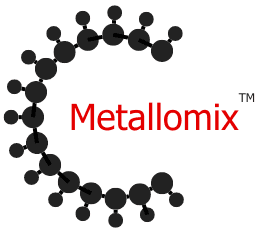Our proprietary Isotope-Selective Modulation (ISMTM) therapies translate our isotopic metallome insights into disruptive new drug candidates to treat disease and promote health.
Our proprietary Isotope-Selective Modulation (ISMTM) therapies translate our isotopic metallome insights into disruptive new drug candidates to treat disease and promote health.
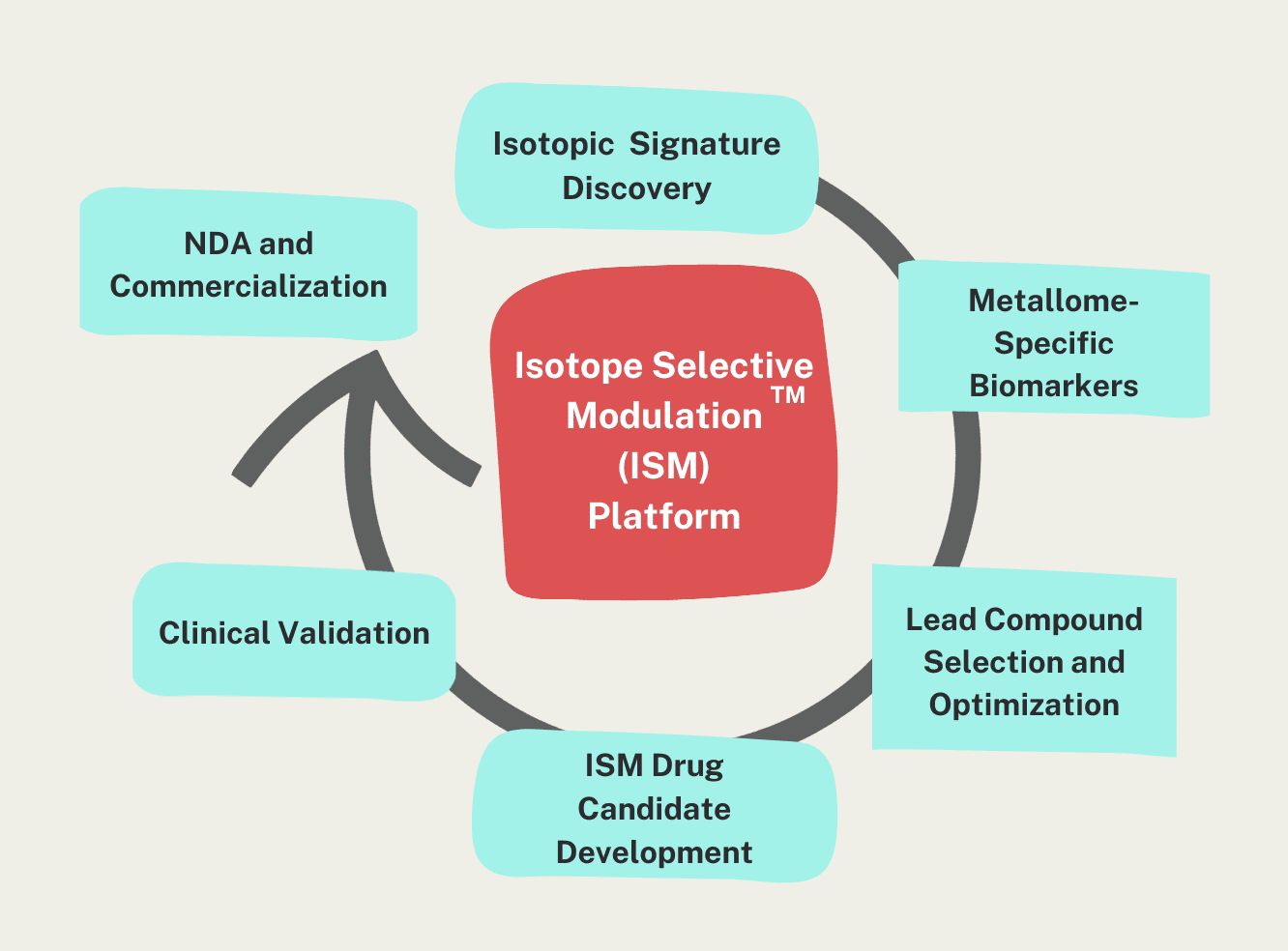
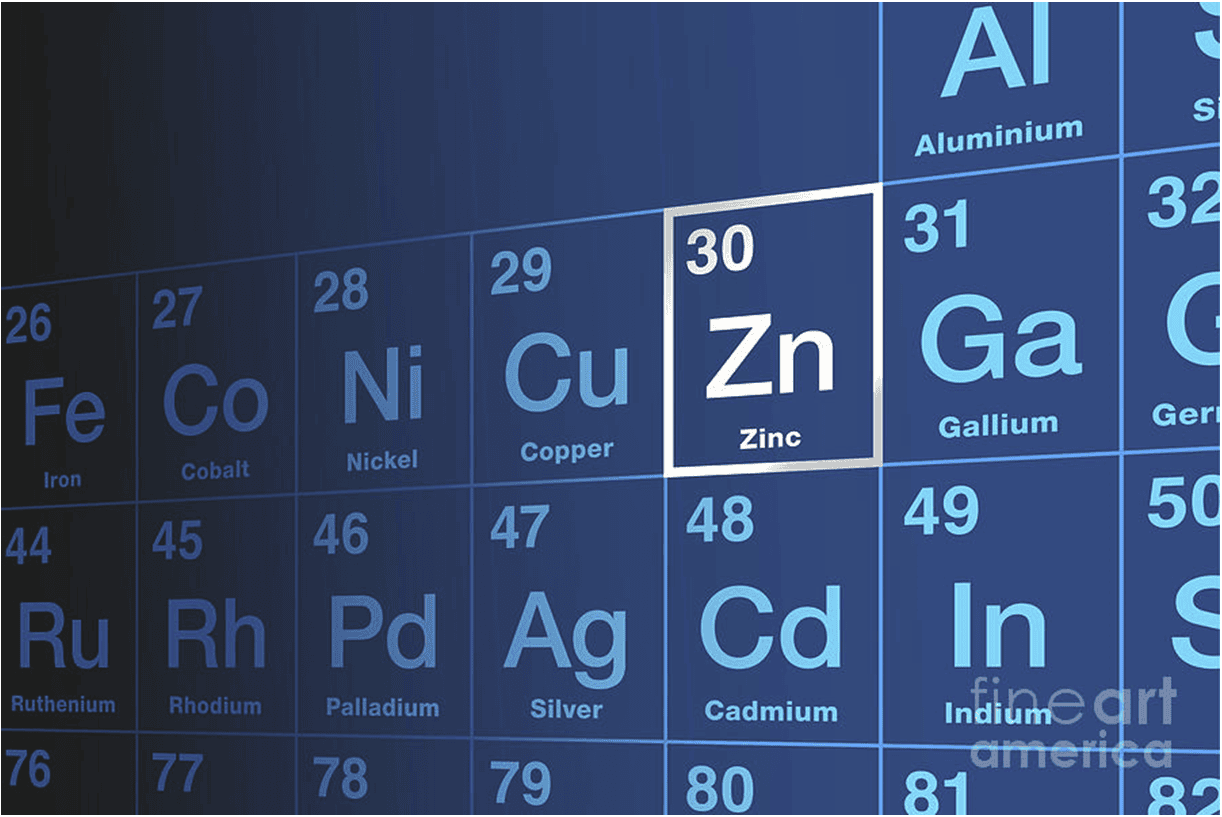
Summary
- Metallomics is an emerging new bioscience combining chemistry, physics, and biology to study the biological roles of various metallic elements, their oxidation state, and their isotopic distribution in cells, tissues, and organs. This opens a new frontier for developing effective and safe therapies significantly impacting and perhaps ultimately curing many diseases.
Isotopic signature are the altered cellular metal isotope distributions characteristic of cancer and other diseases, and of aging (isotopic dysfraction). Understanding these isotopic signatures enables design of isotope modulating therapies to restore healthy cellular functions.
Metallomix Inc. pioneers in the field of isotopic metallomics with patented composition of matter, methods of use, and a proprietary drug discovery platform. Metallomix’s proprietary Isotope-Selective Modulation (ISMTM) therapies translate our metallome insights into disruptive new drug candidates to treat disease and promote health. Our first-in-class ISMTM clinical candidate, KLS-1, is currently enrolling various cancer patients in a Phase 1/2 trial.
Overview
MetallomixTM is a clinical stage biotech company targeting isotopic dysfractionation – a previously unrecognized driver of age-related diseases including cancer and neurodegenerative diseases. The metallome – metals and metalloids in human biology and disease – plays an integral role in various biological functions, including amino acid and protein synthesis, DNA integrity and repair, and mitochondrial metabolism. Metallomics is an emerging interdisciplinary life science that focuses on the comprehensive analysis of metallome in biological systems. This novel area of research integrates aspects of medicine, chemistry, physics, and systems biology to understand the roles that metal ions and metalloids play in living organisms.
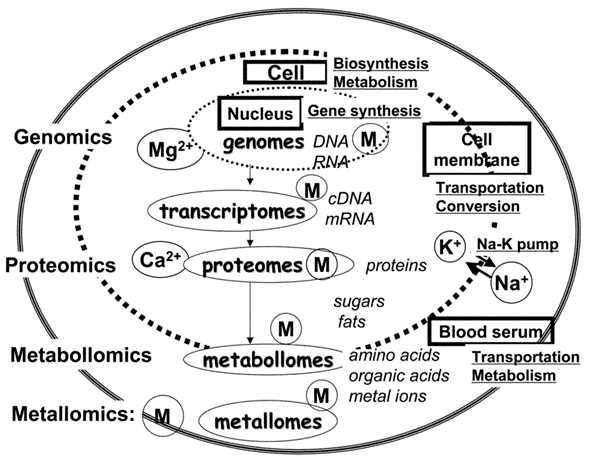
Metallomix is leading the way in isotopic metallomics with patented composition of matter, methods of use, and a proprietary ISMTM drug discovery platform. Our first-in-class ISM clinical candidate, KLS-1, is currently enrolling various cancer patients in a Phase 1/2 trial. Human clinical trials are also being prepared for KLS-1 in healthy volunteers, as well as in neurodegenerative and metabolic diseases. Our mission is to bring novel ISM therapies forward through understanding isotopic dysfractionation, and developing safe, effective, and clinically derisked small molecular isotopic modulators. The isotopically modified drugs have strong potential to create new therapies and to improve the repurposed drugs.
Metals and isotopic fractionation play broad roles in human physiology, and we are currently focused on those roles in tumors, as well as in inflammation and oxidative stress. These are closely interrelated processes that often work in combination, leading to cellular dysfunction and disease progression. By selectively modulating cellular isotopic signatures with enriched stable isotopes, we aim to restore the healthy interplay between cellular homeostasis, inflammation, and oxidative stress, and to offer effective new treatments for cancer, inflammation, and neurodegenerative and other diseases of aging. Understanding these isotope signatures is central to our unique approach to deciphering these diseases and designing drugs to restore healthy cellular function.
Our research illuminates the importance of metallome much more nuanced than simply the function of specific metals or oxidation states, offering a massive and previously unexplored opportunity for drug discovery and development. It shows that in our youth, healthy cells and tissues are enriched with lighter isotopes of essential metals, such as Zn and Fe (healthy isotopic fractionation), which shift towards heavier isotopes in cancer cells and as we age. This “isotopic dysfractionation” of stable (nonradioactive) isotopes triggers and amplifies inflammation, oxidative stress, and disruption of cellular homeostasis – leading to disease.
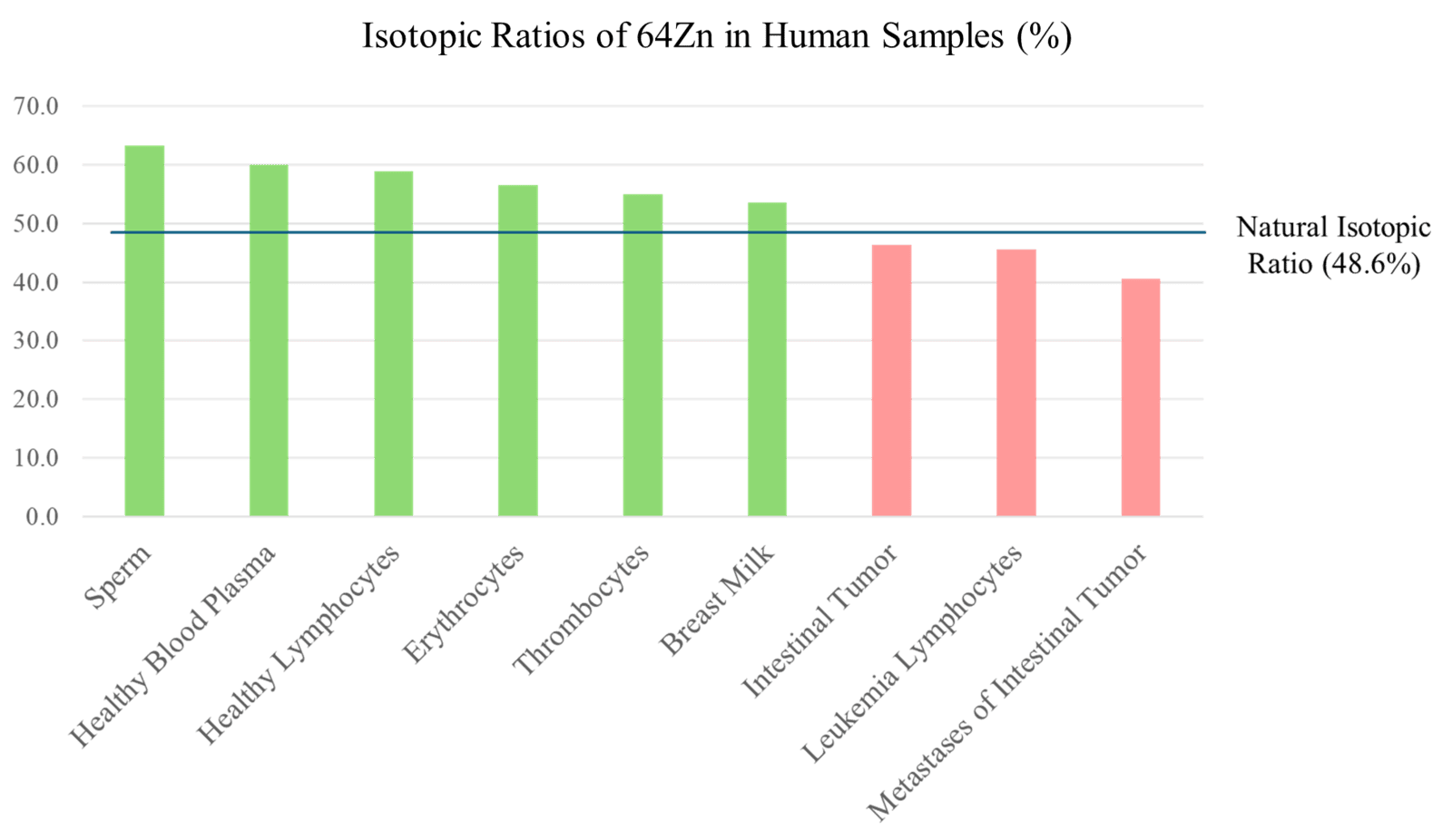
Isotopes are atoms of the same chemical element with different numbers of neutrons in their nucleus. In the context of mammal biology, the isotopic fractionation is a process of isotopic partitioning of atoms in the biological organelles, cells, and tissues of organs. Term “isotopic signatures” refers to the specific ratios of stable isotopes found within cellular components. Our research shows that isotopic ratios of essential metals in mammal cells and tissues differ from that of an inorganic matter.
Our research also shows not only that various isotopic signatures are changing with age, but also that the change in isotopic signatures is a dynamic process accompanying the development of various diseases. In summary, the isotopic signatures of young and healthy cells and tissues feature a prevalence of light isotopes. The development of diseases is accompanied by the shift in isotopic signatures in favor of prevailing heavy isotopes. The following graph illustrates isotope-selective signatures of Ehrlich Ascites Carcinoma - a malignant tumor originated in the breast tissue of a mouse female, which is commonly used in cancer research:

The field of isotopic metallome and studies of isotopic signatures in human cells and tissues are relatively recent. A 2016 in-vivo study in Alzheimer's Disease model by Moynier et al. found that brains of APPswe/PSEN1dE9 mice were enriched in the heavier isotopes of Zn when compared to wild type, suggesting an increase in heavy zinc content of the brain associated with Aβ plaques where zinc binds preferentially to isotopically heavy amino acids such as histidine and glutamate (ref.) A 2021 review by Téa et al. (ref) summarized current knowledge on changes in natural isotope composition in various human diseases. An in-vitro 2022 study by Lauwens et al. examined zinc isotope fractionation in breast cancer tissue and cells, and have confirmed our 2015-2018 findings that breast cancer cells preferentially incorporated isotopically heavier zinc compared to the initial medium (ref.) Another study by Tea et al. attests to the existence of isotopic differences between healthy and cancer biopsy tissues or between healthy and malignant cultured cell lines, and suggests that exploiting isotopic signatures may be “a starting point to possible clinical applications in every cancer that is associated with metabolic changes” (ref.)
We believe that understanding the isotopic signatures is instrumental for deciphering the etiology of diseases and for developing treatments capable of restoring healthy cellular functions. With that thought in mind, we are also designing the ISM related artificial intelligence system, which we believe will become a break-through instrument in diagnosing and treating complex diseases and disfunctions, hence extending the life span. Our current focus is on investigating the bispecific role of stable isotope 64Zinc in human physiology. We selected zinc because of its broad role in many cellular processes, mainly in proteomics, DNA integrity and repair, cellular signaling and regulatory functions. The following diagram illustrates the role of zinc in human physiology.
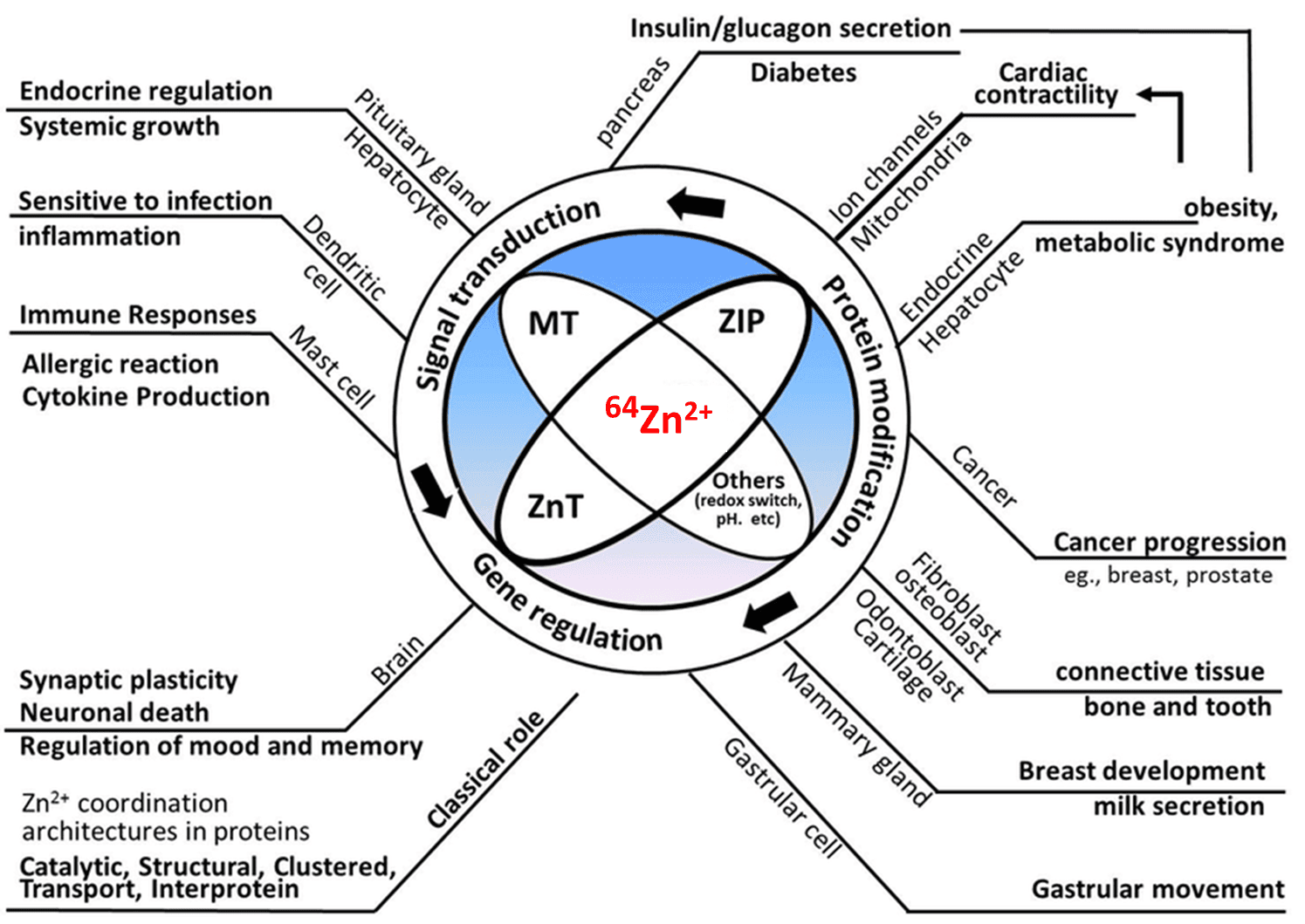
We believe that understanding the isotopic signatures is instrumental for deciphering the etiology of diseases and for developing treatments capable of restoring healthy cellular functions. With that thought in mind, we are also designing the ISM related artificial intelligence system, which we believe will become a break-through instrument in diagnosing and treating complex diseases and disfunctions, hence extending the life span. Our current focus is on investigating the bispecific role of stable isotope 64Zinc in human physiology. We selected zinc because of its broad role in many cellular processes, mainly in proteomics, DNA integrity and repair, cellular signaling and regulatory functions. The following diagram illustrates the role of zinc in human physiology.
